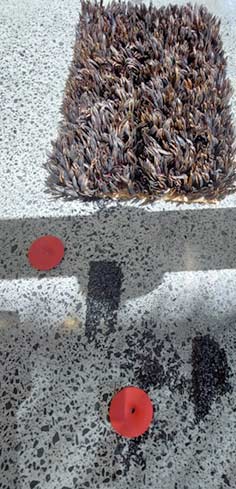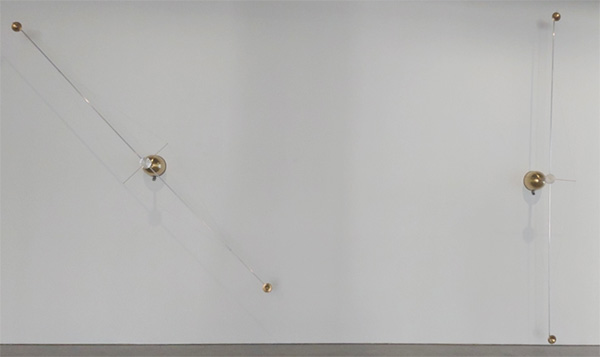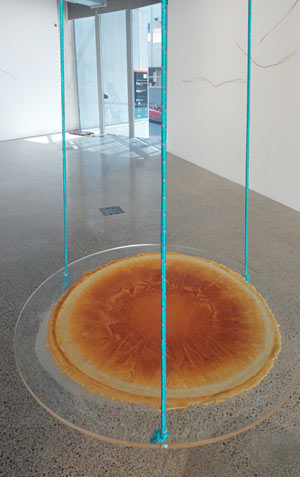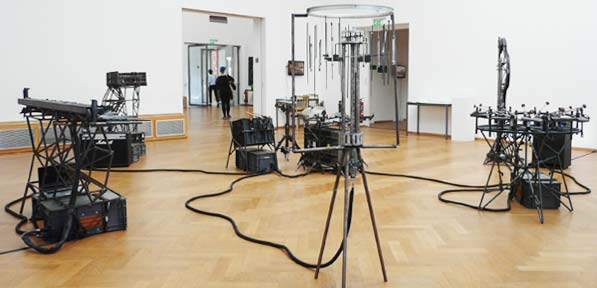my blog and argumentation to come here
Breathing space space breathing
10MarLucy Boermans, Michelle Mayn, Yana Dombrowsky-M’Baye, Shelley Simpson
28 Jan – 11 March 2023
St Paul Street Gallery, Auckland, Aotearoa New Zealand
The exhibition was initiated by phD practice-based AUT (Auckland University of Technology) candidate, Lucy Boermans as an adjunct to the 2-day symposium, Metamodern Creatives (See metamoderncreatives.com).
The Auckland-based artist collective mothermother (mothermother.co.nz) invites two artists at a time to work collaboratively in their Eden Terrace exhibition space. Lucy Boermans and Michelle Mayn met when they were invited in 2021 to create a responsive installation for a 3 week period.
The curated space for mothermother is process-based, transitional and collaborative. Each exhibition, called an iteration, is a reminder that art lives in interaction, and as New Zealand curator, Christine Barton wrote, “history is not seamless, it must be consciously reconstructed.” (artnow.nz/essays/mother-lode?). In line with this nonlinear approach to contemporary art presence, during the 2023 Aotearoa Art Fair, the mothermother collective conducted ‘table chats,’ instead of artist talks. Their tea and cake encouraged visitors and artists to interact around the table.
The St Paul Street Gallery exhibition bore references to
Michelle Mayn and Lucy Boermans’ 2021 collaborative installation in the mothermother space, iteration number 12, (https://www.mothermother.co.nz/iterations/12)
Michelle Mayn has transferred the same materials of intense black flax seeds, with splashes of materials in red, and dried fronds in grid-like arrangments, into new positionings on the floor of the St Paul Street Gallery.
Lucy’s work has transitioned from delicate arrangements between the cracks of the mothermother gallery space to large interactive rotating rods in the more expansive St Paul Street Gallery.
The three piece installation is called “Turning.” The rods turn very slowly, akin to the meditative, however the balls at the ends of the fine rod reminded me that even the spiritual or conceptual rests on physics, when motion is at play. The slowly turning brass spheres almost touch the ground and each other. The work is a response to German/Austrian philosopher Peter Sloterdijk’s theories of Atmospheric Philosophy – thinking on the stuff we just don’t notice – the air we breath. (See: “Something in the air” frieze.com/article/something-air)
Stays restrain the rods, keeping each dead straight – under tension – but the only movement of air here is that created by the slow motion of these rods which stop and start in response to the viewers presence. In that sense, human presence stops or starts ‘the breathing space’ of these elegant beasts which ‘breathe’ the air of this gallery space.
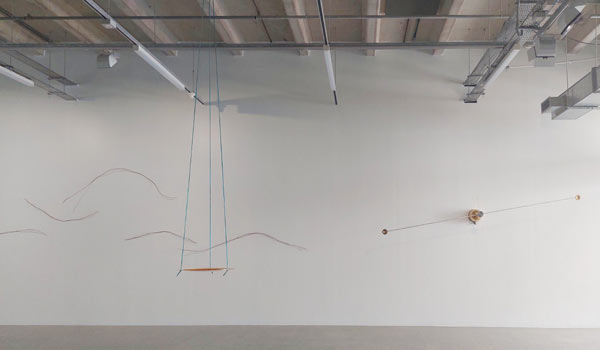
There is a soft repeated sound reminescent of life in a harbour of boats – of the soft brush of metal against metal. The continuous movement, like the tidal waters, complement Shelley Simpson’s distilled vine-like horizontals along the walls. These remind me of the undulations of our natural landscape.
Her petri dish, the size of a satelite dish and holding dried organic matter, hangs from bright blue elastic cord.
Yana’s contribution of finger-pressed clay mouldings along the verticals of the walls at various intervals between the other works make evident that this exhibition is the result of their 10-day collaborative installation process.
The 1 Hour Short Film Festival (ohisff), NorthArt, Auckland
25Oct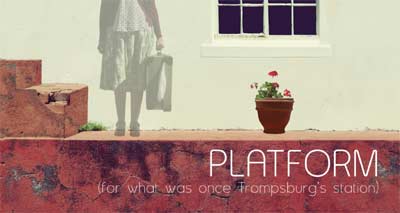
Platform (Perron)
by Marinda du Toit + Tessa Louw, South Africa
2016, 3 min 20 sec.
Animation to the poem, Perron by Andries Bezuidenhout. Part of Filmverse 2 a project for the advancement of Afrikaans poetry and animation.
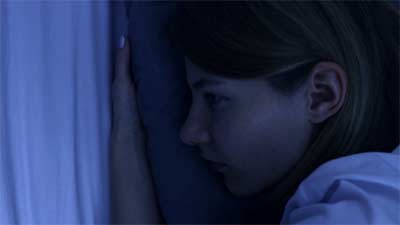
The Edge
by Katarzyna Pajzderska + Veronika Moshnikova, Poland
2018, 2 min 6 sec.
On inner conflicts and on the limits that we set ourselves. Katarzyna based in Poznan is a graduate of the National Film and Television School in Lodz, studying directing in Film & Television Academy in Warsaw. Veronika graduated in 2010 from The Samokish College of Fine Arts in of painting, in Symferopol, Ukraine. Currently she is a doctoral candidate at the Poznan, University of Art, Faculty of Painting and Drawing..
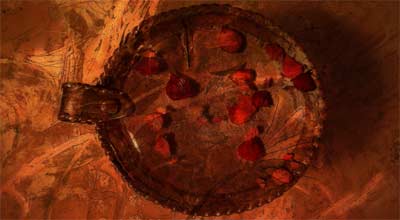
Nights in the gardens of Spain
(Nagte in de tuine van Spanje)
by Theresa Jo Wessels, South Africa
2016, 2 min 6 sec.
Animation to the 2010 poem by Nathan Trantaal. Voice in English: Sylvaine Strike
3-4 pm: an hour of short films by artists, musicians and filmmakers from around the globe.
All films have English trans- lations.
NorthArt Gallery (next to the Northcote Library)
From Iran with Love, Iranian artists in The Hague
8Jul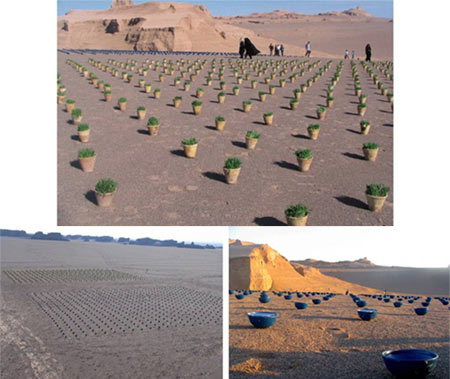
Karim Allahkhani, Loot Desert, Iran, 2006. Installation of 900 flower pots growing wheat grass and 900 bowls of water. Total approximately 3000 square meters.
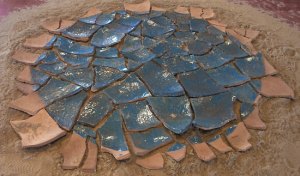
“The Disintegration of unity” ceramic pieces partly glazed, diameter 200 cm, as installed during the residency in the Hague.
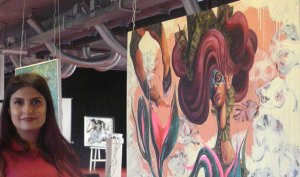
Tina Bateni (from Tehran, Iran) with her painting, Nanotechnology, acrylic on canvas, during the residency in the Hague, June 2018. Photo: Sonja van Kerkhoff
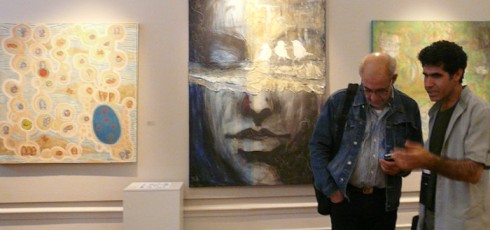
Left to Right: Acrylic on canvas by Diana Valarezo (Ecuador/Belgium) “Song,” acrylic on canvas by Bahareh Aref (Iran/Hamburg), detail of “Love” acrylic on canvas by Maryam Iravani, and Karim Allahkhani (Kerman, Iran) on right in discussion. Photo: Sonja van Kerkhoff
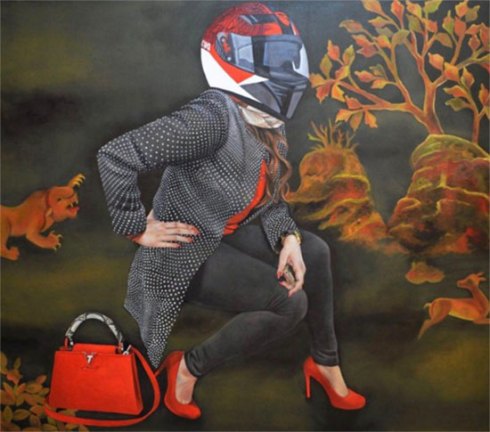
Samira Alborzkouh, Acid Attack, oil on canvas, 140 x 160 cm
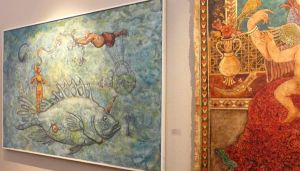
Left to Right: Ghassal (Baptism) by Yousef Abdinejad and a detail of “The Royal Juggernaut” by Saied Khazaie, ecoline on canvas.
Manuchehr Gholami’s gouches are examples of the Negargari style while Saied Khazaie has patched past representations into a mismatch in his work “The royal juggernaut.” Yousef Abdinejad’s “Ghassal” (Baptism) is surreal and whimsical while Tina Bateni’s pop art like painting, “Nanotechnology” and her ‘Head to Toe’ portraits are socio-political comments on the wider world.
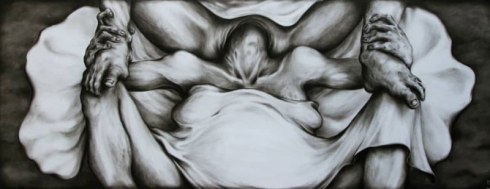
Sahar Eftekharzadeh (from Tehran, Iran) “No.11” acrylic and oil on canvas, 60 x 155 cm
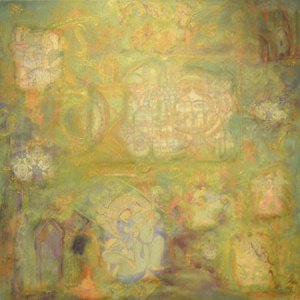
“Love” acrylic on canvas, 100 x 100 cm, by Maryam Iravani (from Isfahan, Iran)
“Putting color on the face of the world” curated by Mitra Jashni
When: 16 June – 8 July 2018, open Tues-Sundays, 12-5pm, Tues-Sundays
Where: Lange Voorhout 15, The Hague
070 – 346 17 35, info@pulchri.nl
About this show on the Pulchri website.
Video introducing the artists.
Artists:
Samira Alborzkouh, Yousef Abdinejad, Karim Allahkhani, Bahareh Aref, Diana Valarezo, Tawab Safi, Salam Djaaz, Saeid Khazaie, Maryam Iravani, Tina Bateni, Claudette van De Rakt, Larissa Oksman, Manuchehr Gholami, Taha Hamed, Maryam Tavakoli, Hero Sheykholeslam, Atefeh Mohammadpour, Sanaz Ahmadi Ashestani, Zahara Sajadifar, Narges Adilipour, Mona Jafarnejad, Sahar Eftekharzadeh, Azam Eisazadeh, Nazanin Nabavi, Farnaz Karimi, Saba Soleymani, Hamed Heidari, Mehdi Noori, Afshin Bagheri, Amir Mansour Almaloo, Elmira Amirazodi, Morteza Mottaghi, Maryam Khorami, Marzieh Nazemzadeh, Leila Banki, Shadi Pahlavani.
Disarm at TodaysArt, The Hague
26Sep23-25 September 2016
“For Pedro Reyes the process of transforming weapons into objects of positive utility was more than physical. “It’s important to consider that many lives were taken with these weapons; as if a sort of exorcism was taking place, the music expelled the demons they held, as well as being a requiem for the lives lost.” Artlyst.com, 25 Sept, 2015
“Pedro Reyes’ work is a socio-political critique on contemporary society and our responsibility towards it. His projects are catalysts for communal and psychological transformation, triggering group interaction and creativity.
Disarm is a demand for towns and cities across the world to relinquish their weapons and transform them from agents of death to agents of life. It is an attempt to highlight the invisible violence that underpins the international industry of death and suffering: the commercial and government complicity that allows for weapons to be made and sold by public companies for shareholder profit; the laws banning assault rifles which go neglected; and the films and video-games which depict trigger-happy heroes. For Reyes, an idealist whose projects affect real change and are often explicit attempts to improve the society around him, a world free of guns is a human right, and a utopian ideal to which we should all aspire.” Lisson Gallery, 2013, London.
Pedro Reyes was born in Mexico City in 1972, where he lives and works. He has won international attention for his large-scale projects that associate social issues with imaginative solutions. Pedro Reyes was awarded a Medal for the Arts in January 2015, by the US State Department for his continued commitment to the State Department’s cultural diplomacy outreach.
See his website or his blog for more.
TodaysArt Festival, hosted annually since 2005 in the Hague, focusses on the presentation and development of contemporary visual and performing arts and emerging culture. About the 2016 edition.

